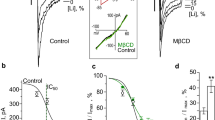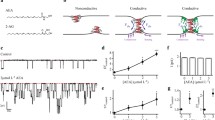Abstract
Voltage-gated, CaV2.3 calcium channels and neurokinin-1 (NK1) receptors are both present in nuclei of the central nervous system. When transiently coexpressed in human embryonic kidney (HEK) 293 cells, CaV2.3 is primarily inhibited during strong, agonist-dependent activation of NK1 receptors. NK1 receptors localize to plasma membrane rafts, and their modulation by Gq/11 protein-coupled signaling is sensitive to plasma membrane cholesterol. Here, we show that inhibition of CaV2.3 by NK1 receptors is attenuated following methyl-β-cyclodextrin (MBCD)-mediated depletion of membrane cholesterol. By contrast, inhibition of CaV2.3 was unaffected by intracellular diffusion of caveolin-1 scaffolding peptide or by overexpression of caveolin-1. Interestingly, MΒCD treatment had no effect on the macroscopic biophysical properties of CaV2.3, though it significantly decreased whole-cell membrane capacitance. Our data indicate that (1) cholesterol supports at least one component of the NK1 receptor-linked signaling pathway that inhibits CaV2.3 and (2) caveolin-1 is dispensable within this pathway. Our findings suggest that NK1 receptors reside within non-caveolar membrane rafts and that CaV2.3 resides nearby but outside the rafts. Raft-dependent modulation of CaV2.3 could be important in the physiological and pathophysiological processes in which these channels participate, including neuronal excitability, synaptic plasticity, epilepsy, and chronic pain.





Similar content being viewed by others
References
Adelson D, Lao L, Zhang G, Kim W, Marvizón JC (2009) Substance P release and neurokinin 1 receptor activation in the rat spinal cord increase with the firing frequency of C-fibers. Neuroscience 161:538–553. doi:10.1016/j.neuroscience.2009
Balijepalli RC, Foell JD, Hall DD, Hell JW, Kamp TJ (2006) Localization of cardiac L-type Ca2+ channels to a caveolar macromolecular signaling complex is required for β2-adrenergic regulation. Proc Natl Acad Sci U S A 103:7500–7505
Bowles DK, Heaps CL, Turk JR, Maddali KK, Price EM (2004) Hypercholesterolemia inhibits L-type calcium current in coronary macro-, not microcirculation. J Appl Physiol 96:2240–2248
Breustedt J, Vogt KE, Miller RJ, Nicoll RA, Schmitz D (2003) α1E-containing Ca2+ channels are involved in synaptic plasticity. Proc Natl Acad Sci U S A 100:12450–12455
Brockerhoff H (1974) Model of interaction of polar lipids, cholesterol, and proteins in biological membranes. Lipids 9:645–650
Chen CA, Manning DR (2001) Regulation of G proteins by covalent modification. Oncogene 20:1643–1652
Christian AE, Haynes MP, Phillips MC, Rothblat GH (1997) Use of cyclodextrins for manipulating cellular cholesterol content. J Lipid Res 38:2264–2272
Cornelius F (2001) Modulation of Na,K-ATPase and Na-ATPase activity by phospholipids and cholesterol. I. Steady-state kinetics. Biochemistry 40:8842–8851
Couet J, Li S, Okamoto T, Ikezu T, Lisanti MP (1997) Identification of peptide and protein ligands for the caveolin-scaffolding domain. Implications for the interaction of caveolin with caveolae-associated proteins. J Biol Chem 272:6525–6533
Davies LM, Purves GI, Barrett-Jolley R, Dart C (2010) Interaction with caveolin-1 modulates vascular ATP-sensitive potassium (KATP) channel activity. J Physiol 588:3255–5266. doi:10.1113/jphysiol.2010.194779
De Felipe C, Herrero JF, O'Brien JA, Palmer JA, Doyle CA, Smith AJ, Laird JM, Belmonte C, Cervero F, Hunt SP (1998) Altered nociception, analgesia and aggression in mice lacking the receptor for substance P. Nature 392:394–397
Drab M, Verkade P, Elger M, Kasper M, Lohn M, Lauterbach B, Menne J, Lindschau C, Mende F, Luft FC, Schedl A, Haller H, Kurzchalia TV (2001) Loss of caveolae, vascular dysfunction, and pulmonary defects in caveolin-1 gene-disrupted mice. Science 293:2449–2452
Finkelstein A, Cass A (1968) Permeability and electrical properties of thin lipid membranes. J Gen Physiol 52:145–172
Fisher KA (1976) Analysis of membrane halves: cholesterol. Proc Natl Acad Sci U S A 73:173–177
Hanson MA, Cherezov V, Griffith MT, Roth CB, Jaakola VP, Chien EY, Velasquez J, Kuhn P, Stevens RC (2008) A specific cholesterol binding site is established by the 2.8 A structure of the human β2-adrenergic receptor. Structure 16:897–905. doi:10.1016/j.str.2008.05.001
Head BP, Patel HH, Insel PA (2014) Interaction of membrane/lipid rafts with the cytoskeleton: impact on signaling and function: membrane/lipid rafts, mediators of cytoskeletal arrangement and cell signaling. Biochim Biophys Acta 1838:532–545. doi:10.1016/j.bbamem.2013.07.018
Heiberger RM, Holland B (2004) Statistical analysis and data display: an intermediate course with examples in S-Plus, R and SAS. Springer, New York
Khatibzadeh N, Gupta S, Farrell B, Brownell WE, Anvari B (2012) Effects of cholesterol on nano-mechanical properties of the living cell plasma membrane. Soft Matter 8:8350–8360
Kusumi A, Suzuki KG, Kasai RS, Ritchie K, Fujiwara TK (2011) Hierarchical mesoscale domain organization of the plasma membrane. Trends Biochem Sci 36:604–615. doi:10.1016/j.tibs.2011.08.001
Lariccia V, Fine M, Magi S, Lin MJ, Yaradanakul A, Llaguno MC, Hilgemann DW (2011) Massive calcium-activated endocytosis without involvement of classical endocytic proteins. J Gen Physiol 137:111–132. doi:10.1085/jgp.201010468
Lee SC, Choi S, Lee T, Kim HL, Chin H, Shin HS (2002) Molecular basis of R-type calcium channels in central amygdala neurons of the mouse. Proc Natl Acad Sci U S A 99:3276–3281
Levitan I, Fang Y, Rosenhouse-Dantsker A, Romanenko V (2010) Cholesterol and ion channels. Subcell Biochem 51:509–549. doi:10.1007/978-90-481-8622-8_19
Lingwood D, Simons K (2010) Lipid rafts as a membrane-organizing principle. Science 327:46–50. doi:10.1126/science.1174621
Lundbaek JA (2008) Lipid bilayer-mediated regulation of ion channel function by amphiphilic drugs. J Gen Physiol 131:421–429. doi:10.1085/jgp.200709948
Macdonald SG, Dumas JJ, Boyd ND (1996) Chemical cross-linking of the substance P (NK-1) receptor to the alpha subunits of the G proteins Gq and G11. Biochemistry 35:2909–2916
Metz AE, Jarsky T, Martina M, Spruston N (2005) R-type calcium channels contribute to afterdepolarization and bursting in hippocampal CA1 pyramidal neurons. J Neurosci 25:5763–5773
Meyer BH, Segura JM, Martinez KL, Hovius R, George N, Johnsson K, Vogel H (2006) FRET imaging reveals that functional neurokinin-1 receptors are monomeric and reside in membrane microdomains of live cells. Proc Natl Acad Sci U S A 103:2138–2143
Meza U, Thapliyal A, Bannister RA, Adams BA (2007) Neurokinin 1 receptors trigger overlapping stimulation and inhibition of CaV2.3 (R-type) calcium channels. Mol Pharmacol 71:284–293
Monastyrskaya K, Hostettler A, Buergi S, Draeger A (2005) The NK1 receptor localizes to the plasma membrane microdomains, and its activation is dependent on lipid raft integrity. J Biol Chem 280:7135–7146
Murakami M, Nakagawasai O, Suzuki T, Mobarakeh II, Sakurada Y, Murata A, Yamadera F, Miyoshi I, Yanai K, Tan-No K, Sasano H, Tadano T, Iijima T (2004) Antinociceptive effect of different types of calcium channel inhibitors and the distribution of various calcium channel α1 subunits in the dorsal horn of spinal cord in mice. Brain Res 1024:122–129
Murase K, Fujiwara T, Umemura Y, Suzuki K, Iino R, Yamashita H, Saito M, Murakoshi H, Ritchie K, Kusumi A (2004) Ultrafine membrane compartments for molecular diffusion as revealed by single molecule techniques. Biophys J 86:4075–4093
Newcomb R, Szoke B, Palma A, Wang G, Chen X, Hopkins W, Cong R, Miller J, Urge L, Tarczy-Hornoch K, Loo JA, Dooley DJ, Nadasdi L, Tsien RW, Lemos J, Miljanich G (1998) Selective peptide antagonist of the class E calcium channel from the venom of the tarantula Hysterocrates gigas. Biochemistry 37:15353–15362
Niidome T, Kim MS, Friedrich T, Mori Y (1992) Molecular cloning and characterization of a novel calcium channel from rabbit brain. FEBS Lett 308:7–13
Ocharan E, Asbun J, Calzada C, Mendez E, Nuñez M, Medina R, Suarez G, Meaney E, Ceballos G (2005) Caveolin scaffolding peptide-1 interferes with norepinephrine-induced PLCβ activation in cultured rat vascular smooth muscle cells. J Cardiovasc Pharmacol 46:615–621
Oldfield S, Hancock J, Mason A, Hobson SA, Wynick D, Kelly E, Randall AD, Marrion NV (2009) Receptor-mediated suppression of potassium currents requires colocalization within lipid rafts. Mol Pharmacol 76:1279–1289. doi:10.1124/mol.109.058008
Osanai M, Saegusa H, Kazuno AA, Nagayama S, Hu Q, Zong S, Murakoshi T, Tanabe T (2006) Altered cerebellar function in mice lacking CaV2.3 Ca2+ channel. Biochem Biophys Res Commun 344:920–925
Parajuli LK, Nakajima C, Kulik A, Matsui K, Schneider T, Shigemoto R, Fukazawa Y (2012) Quantitative regional and ultrastructural localization of the CaV2.3 subunit of R-type calcium channel in mouse brain. J Neurosci 32:13555–13567
Parton RG, del Pozo MA (2013) Caveolae as plasma membrane sensors, protectors and organizers. Nat Rev Mol Cell Biol 14:98–112. doi:10.1038/nrm3512
Pike LJ (2006) Rafts defined: a report on the keystone symposium on lipid rafts and cell function. J Lipid Res 47:1597–1598
Piedras-Rentería ES, Tsien RW (1998) Antisense oligonucleotides against α1E reduce R-type calcium currents in cerebellar granule cells. Proc Natl Acad Sci U S A 95:7760–7765
Pouvreau S, Berthier C, Blaineau S, Amsellem J, Coronado R, Strube C (2004) Membrane cholesterol modulates dihydropyridine receptor function in mice fetal skeletal muscle cells. J Physiol 555:365–381
Rodal SK, Skretting G, Garred O, Vilhardt F, van Deurs B, Sandvig K (1999) Extraction of cholesterol with methyl-β-cyclodextrin perturbs formation of clathrin-coated endocytic vesicles. Mol Biol Cell 10:961–974
Romanenko VG, Rothblat GH, Levitan I (2002) Modulation of endothelial inward-rectifier K+ current by optical isomers of cholesterol. Biophys J 83:3211–3222
Saegusa H, Kurihara T, Zong S, Minowa O, Kazuno A, Han W, Matsuda Y, Yamanaka H, Osanai M, Noda T, Tanabe T (2000) Altered pain responses in mice lacking α1E subunit of the voltage-dependent Ca2+ channel. Proc Natl Acad Sci U S A 97:6132–6137
Shmygol A, Noble K, Wray S (2007) Depletion of membrane cholesterol eliminates the Ca2+-activated component of outward potassium current and decreases membrane capacitance in rat uterine myocytes. J Physiol 581:445–456
Simonds WF, Butrynski JE, Gautam N, Unson CG, Spiegel AM (1991) G-protein βγ dimers. Membrane targeting requires subunit coexpression and intact γ C-A-A-X domain. J Biol Chem 266:5363–5366
Simons K, Toomre D (2000) Lipid rafts and signal transduction. Nat Rev Mol Cell Biol 1:31–39
Simons K, Sampaio JL (2011) Membrane organization and lipid rafts. Cold Spring Harb Perspect Biol 3:a004697. doi:10.1101/cshperspect.a004697
Thomas P, Smart TG (2005) HEK293 cell line: a vehicle for the expression of recombinant proteins. J Pharmacol Toxicol Methods 51:187–200
Tikku S, Epshtein Y, Collins H, Travis AJ, Rothblat GH, Levitan I (2007) Relationship between Kir2.1/Kir2.3 activity and their distributions between cholesterol-rich and cholesterol-poor membrane domains. Am J Physiol Cell Physiol 293:C440–C450
Toselli M, Taglietti V, Parente V, Flati S, Pavan A, Guzzi F, Parenti M (2001) Attenuation of G protein-mediated inhibition of N-type calcium currents by expression of caveolins in mammalian NG108-15 cells. J Physiol 536:361–373
Toselli M, Biella G, Taglietti V, Cazzaniga E, Parenti M (2005) Caveolin-1 expression and membrane cholesterol content modulate N-type calcium channel activity in NG108-15 cells. Biophys J 89:2443–2457
Tsujikawa H, Song Y, Watanabe M, Masumiya H, Gupte SA, Ochi R, Okada T (2008) Cholesterol depletion modulates basal L-type Ca2+ current and abolishes its β-adrenergic enhancement in ventricular myocytes. Am J Physiol Heart Circ Physiol 294:H285–H292
Westenbroek RE, Hoskins L, Catterall WA (1998) Localization of Ca2+ channel subtypes on rat spinal motor neurons, interneurons, and nerve terminals. J Neurosci 18:6319–6330
Yang YT, Liao JD, Lin CCK, Chang CT, Wang SH, Ju MS (2012) Characterization of colesterol-deleted or -restored cell membranes by depth-sensing nano-indentation. Soft Matter 8:682–687. doi:10.1039/c1sm06180a
Yokoyama K, Kurihara T, Saegusa H, Zong S, Makita K, Tanabe T (2004) Blocking the R-type (Cav2.3) Ca2+ channel enhanced morphine analgesia and reduced morphine tolerance. Eur J Neurosci 20:3516–3519
Acknowledgments
We thank Dr. Caroline Dart (University of Liverpool, Liverpool, UK) for sharing the rat caveolin-1 expression plasmid. We thank Dr. Brett Adams (Utah State University, Logan, UT, USA) and Dr. Roger A. Bannister (University of Colorado Denver-AMC, Aurora, CO, USA) for helpful comments on the manuscript. We thank Nohelia Meza-Meza for helpful suggestions on the manuscript. This work was supported by grants from CONACyT (169006 to U.M.; 155035 to S.S-A; 157245 to A.A.R-M) and the Universidad Autónoma de San Luis Potosí (C13-FRC-01-03.03 to U.M.; C-12-FRC-09-12.12 to S.S-A.; C12-FRC-09-19.19 to A.A.R-M.).
Conflict of interest
The authors declare that they have no conflict of interest.
Author information
Authors and Affiliations
Corresponding author
Rights and permissions
About this article
Cite this article
Licon, Y., Leandro, D., Romero-Mendez, C. et al. Inhibition of CaV2.3 channels by NK1 receptors is sensitive to membrane cholesterol but insensitive to caveolin-1. Pflugers Arch - Eur J Physiol 467, 1699–1709 (2015). https://doi.org/10.1007/s00424-014-1605-0
Received:
Revised:
Accepted:
Published:
Issue Date:
DOI: https://doi.org/10.1007/s00424-014-1605-0




